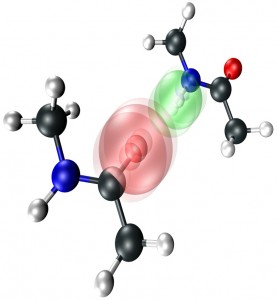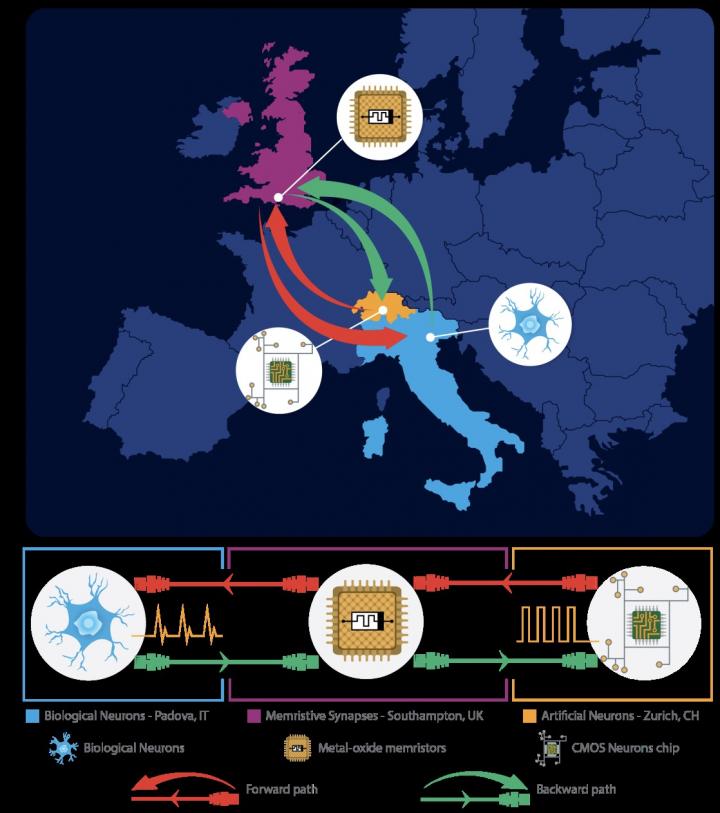This post features two items about water both of which suggest we should reconsider our ideas about it. This first item concerns hydrogen bonds and coordinated vibrations. From a July 16 2014 news item on Azonano,
Using a newly developed, ultrafast femtosecond infrared light source, chemists at the University of Chicago have been able to directly visualize the coordinated vibrations between hydrogen-bonded molecules — the first time this sort of chemical interaction, which is found in nature everywhere at the molecular level, has been directly visualized. They describe their experimental techniques and observations in The Journal of Chemical Physics, from AIP [American Institute of Physics] Publishing.
“These two-dimensional infrared spectroscopy techniques provide a new avenue to directly visualize both hydrogen bond partners,” said Andrei Tokmakoff, the lab’s primary investigator. “They have the spectral content and bandwidth to really interrogate huge parts of the vibrational spectrum of molecules. It’s opened up the ability to look at how very different types of vibrations on different molecules interact with one another.”
A July 15, 2014 AIP news release by John Arnst (also on EurekAlert), which originated the news item, provides more detail,
Tokmakoff and his colleagues sought to use two-dimensional infrared spectroscopy to directly characterize structural parameters such as intermolecular distances and hydrogen-bonding configurations, as this information can be encoded in intermolecular cross-peaks that spectroscopy detects between solute-solvent vibrations.
“You pluck on the bonds of one molecule and watch how it influences the other,” Tokmakoff said. “In our experiment, you’re basically plucking on both because they’re so strongly bound.”
Hydrogen bonds are typically perceived as the attractive force between the slightly negative and slightly positive ends of neutrally-charged molecules, such as water. While water stands apart with its unique polar properties, hydrogen bonds can form between a wide range of molecules containing electronegative atoms and range from weakly polar to nearly covalent in strength. Hydrogen bonding plays a key role in the action of large, biologically-relevant molecules and is often an important element in the discovery of new pharmaceuticals.
For their initial visualizations, Tokmakoff’s group used N-methylacetamide, a molecule called a peptide that forms medium-strength hydrogen-bonded dimers in organic solution due to its polar nitrogen-hydrogen and carbon-oxygen tails. By using a targeted three-pulse sequence of mid-infrared light and apparatus described in their article, Tokmakoff’s group was able to render the vibrational patterns of the two peptide units.
“All of the internal vibrations of hydrogen bonded molecules that we look at become intertwined, inextricably; you can’t think of them as just a simple sum of two parts,” Tokmakoff said.
More research is being planned while Tokmakoff suggests that water must be rethought from an atomistic perspective (from the news release),
Future work in Tokmakoff’s group involves visualizing the dynamics and structure of water around biological molecules such as proteins and DNA.
“You can’t just think of the water as sort of an amorphous solvent, you really have to at least on some level think of it atomistically and treat it that way,” Tokmakoff said. “And if you believe that, it has huge consequences all over the place, particularly in biology, where so much computational biology ignores the fact that water has real structure and real quantum mechanical properties of its own.”
The researchers have provided an illustration of hydrogen’s vibrating bonds,

The hydrogen-bonding interaction causes the atoms on each individual N-methylacetamide molecule to vibrate in unison.
CREDIT: L. De Marco/UChicago
Here’s a link to and a citation for the paper,
Direct observation of intermolecular interactions mediated by hydrogen bonding by Luigi De Marco, Martin Thämer, Mike Reppert, and Andrei Tokmakoff. J. Chem. Phys. 141, 034502 (2014); http://dx.doi.org/10.1063/1.4885145
This paper is open access. (I was able to view the entire HTML version.)
A July 15, 2014 University of Southampton press release on EurekAlert offers another surprise about water,
University of Southampton researchers have found that rainwater can penetrate below the Earth’s fractured upper crust, which could have major implications for our understanding of earthquakes and the generation of valuable mineral deposits.
The reason that water’s ability to penetrate below the earth’s upper crust is a surprise (from the news release),
It had been thought that surface water could not penetrate the ductile crust – where temperatures of more than 300°C and high pressures cause rocks to flex and flow rather than fracture – but researchers, led by Southampton’s Dr Catriona Menzies, have now found fluids derived from rainwater at these levels.
The news release also covers the implications of this finding,
Fluids in the Earth’s crust can weaken rocks and may help to initiate earthquakes along locked fault lines. They also concentrate valuable metals such as gold. The new findings suggest that rainwater may be responsible for controlling these important processes, even deep in the Earth.
Researchers from the University of Southampton, GNS Science (New Zealand), the University of Otago, and the Scottish Universities Environmental Research Centre studied geothermal fluids and mineral veins from the Southern Alps of New Zealand, where the collision of two tectonic plates forces deeper layers of the earth closer to the surface.
The team looked into the origin of the fluids, how hot they were and to what extent they had reacted with rocks deep within the mountain belt.
“When fluids flow through the crust they leave behind deposits of minerals that contain a small amount of water trapped within them,” says Postdoctoral Researcher Catriona, who is based at the National Oceanography Centre. “We have analysed these waters and minerals to identify where the fluids deep in the crust came from.
“Fluids may come from a variety of sources in the crust. In the Southern Alps fluids may flow upwards from deep in the crust, where they are released from hot rocks by metamorphic reactions, or rainwater may flow down from the surface, forced by the high mountains above. We wanted to test the limits of where rainwater may flow in the crust. Although it has been suggested before, our data shows for the first time that rainwater does penetrate into rocks that are too deep and hot to fracture.”
Surface-derived waters reaching such depths are heated to over 400°C and significantly react with crustal rocks. However, through testing the researchers were able to establish the water’s meteoric origin.
Funding for this research, which has been published in Earth and Planetary Science Letters, was provided by the Natural Environmental Research Council (NERC). Catriona and her team are now looking further at the implications of their findings in relation to earthquake cycles as part of the international Deep Fault Drilling Project [DFDP], which aims to drill a hole through the Alpine Fault at a depth of about 1km later this year.
Here’s a link to and a citation for the paper,
Incursion of meteoric waters into the ductile regime in an active orogen by Catriona D. Menzies, Damon A.H. Teagle, Dave Craw, Simon C. Cox, Adrian J. Boyce, Craig D. Barrie, and Stephen Roberts. Earth and Planetary Science Letters Volume 399, 1 August 2014, Pages 1–13 DOI: 10.1016/j.epsl.2014.04.046
Open Access funded by Natural Environment Research Council
This is the first time I’ve seen the funding agency which made the paper’s open access status possible cited.


